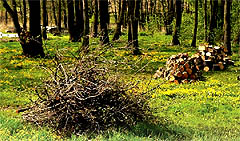
Cellulosic Ethanol
Cellulosic ethanol, which comes from non-corn feedstocks such as woody biomass, is touted as “the holy grail of biofuels.” As a renewable fuel source that is produced domestically and is carbon-neutral, biomass is an attractive alternative to fossil fuels. Yet economical production has proven elusive. In fact, commercialization has been “about five years away” for decades. Scientists continue to dispute the best technique for converting biomass to ethanol and, to date, there are no commercial-scale cellulosic ethanol refineries in operation.
Although production of cellulosic ethanol is meager compared to corn-based ethanol, there are advantages to creating ethanol from biomass rather than corn. Cellulosic ethanol does not interfere with food production or require intensive agriculture. Raw materials—including not only wood, but grasses, yard trimmings, and even municipal waste—are abundant and cheap.
On the other hand, cellulosic ethanol is expensive to produce—$3.35 per gallon compared to $2.35 for corn-based ethanol, according to a report by Cato Institute economists Jerry Taylor and Peter Van Doren. Both are more costly than gasoline, which is currently selling for approximately $2.05 at the pump. To keep the alternative fuel competitive, the federal government has subsidized ethanol since the 1970s. Doug Koplow from the energy subsidy research firm Earth Track, estimates that ethanol subsidies are between $1.05 and $1.38 per gallon, or around $5.1 billion to $6.8 billion annually.
For decades, paper and lumber mills have found that they can reduce their energy bills by using sawdust and other byproducts to produce heat and power for their facilities.
Not only does the government subsidize ethanol, it mandates its production. The Energy Security and Independence Act of 2007 requires the annual production of 36 billion gallons of ethanol for transportation fuel by 2022. Of this, 16 billion gallons must be cellulosic ethanol.
The combination of the subsidy and the mandate will cost taxpayers billions of dollars. A more efficient approach would be to support research aimed at bringing the costs of production of cellulosic ethanol down, so that the fuel could be competitive with gasoline without a subsidy.
For example, Coskata—a renewable energy company—claims that it can produce cellulosic ethanol for less than $1 per gallon. Although this technology is still small-scale, and far from commercially available, it represents a possibility that the ethanol subsidy could be eliminated. Until that happens, the best place for cellulosic ethanol is a laboratory, not your gas tank.
Biopower

Some mills are going one step further and selling electricity on the grid. One example is on the Warm Springs Indian Reservation in Oregon, where the tribal mill has generated heat and power since the 1970s. An abundance of biomass has spurred the tribes to consider increasing power production for sale to Oregon consumers.
The tribes manage 400,000 acres of forest, and much of this is in need of restoration to mitigate fire risks. In addition, the tribes will use biomass from neighboring Forest Service and Bureau of Land Management lands. The power plant will run on 125,000 dry tons of biomass each year, producing 15 megawatts of electricity—enough to power 15,000 homes.
Like ethanol, biopower producers receive some support from the government. For example, since 1992, biopower producers have been able to take advantage of tax credits amounting to as much as $1.5 billion annually in recent years, according to Koplow. While this is a considerable sum, it is still much less than the multi-billion dollar ethanol subsidies.
Even before tax credits for biopower were available, mills were able to save money by generating electricity from biomass. This indicates that with an abundant source of biomass on hand, generating power from wood is an economically feasible operation that can provide an outlet for non-timber forest products as well as an alternative to fossil fuels.
Feed the Fire
A decidedly low-tech option might be the best outlet for woody biomass: burning wood for heat. Although this idea is far from cutting edge, it has provided a solution for high heating costs and overgrown forests in many areas of the country.
States like Montana, Nevada, North Dakota, Wyoming, and Utah, for example, have developed “Fuels for Schools” programs, which take fuels for wildfire out of the woods, and use the biomass to heat schools or other public buildings.
The small town of Darby, Montana, in the Bitterroot Valley south of Missoula, was one of the first communities in the Rockies to install wood-powered boilers in their schools. Darby is surrounded by national forests and local residents were well aware of heightened fire risks on federal lands.
After Congress passed the National Fire Plan in 2000 and the Healthy Forests Restoration Act in 2003, federal fuels reduction treatments increased, leaving forest managers in the Darby area with loads of biomass at their disposal. At the same time, Darby school administrators were looking to cut down on heating costs. As a result, the Montana Fuels for Schools program sprang to life.

States like Montana, Nevada, North Dakota, Wyoming, and Utah, for example, have developed “Fuels for Schools” programs, which take fuels for wildfire out of the woods, and use the biomass to heat schools or other public buildings.
Wood heat is not subsidized anywhere near the level of ethanol or biopower. Between 2001 and 2003, the Fuels for Schools program received about $2.2 million in federal funding, according to a recent study from the Forest Service and the University of Minnesota—pennies compared to the handouts to ethanol and biopower. Furthermore, even without federal dollars, schools can save money by heating with wood. Indeed, the best use for biomass may simply be to burn it.
Tried and True
Woody biomass is an untapped resource with much potential. A market for this forest product would better encourage forest restoration, fire risk reduction, and supplement timber dollars. Producing energy from biomass may seem like an ideal situation—reducing dependence on fossil fuels while addressing forest health issues. But a closer look reveals some problems. Most prominently, the alternative energy industry is rife with subsidies, with ethanol enjoying the highest amount of government support.
Using biomass to generate heat and power is a more practical solution. Unlike ethanol, generating power and heat from wood saves consumers money when compared to traditional fuel sources. As the Warm Springs Reservation and the Fuels for Schools program demonstrate, biomass can generate heat and power effectively and economically. In these cases, energy production is creating a market for an otherwise unused resource—and helping forest restoration at the same time.


